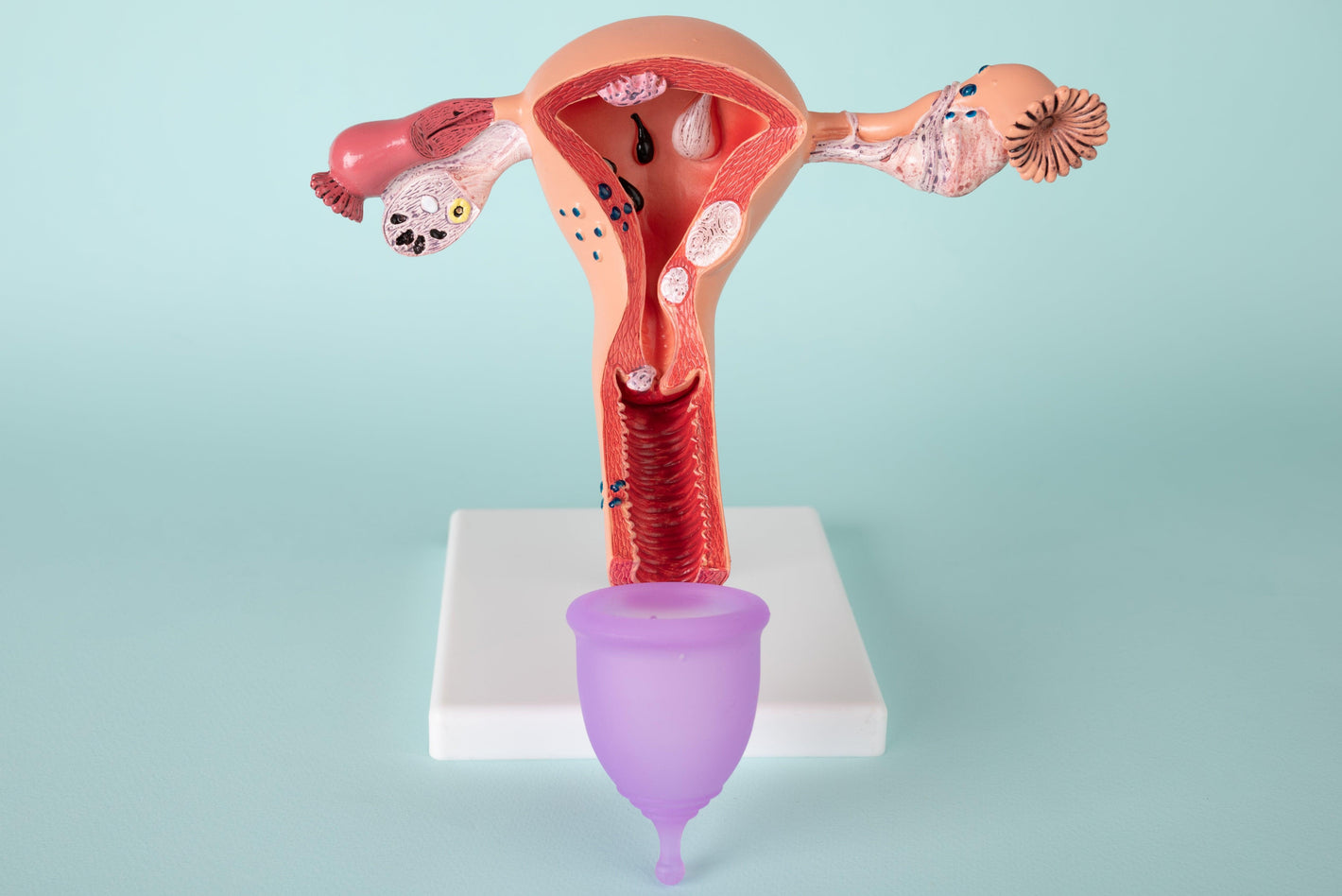Let's talk about vaginal discharge.
.png?v=1670843984822)

Related products
What’s covered?
Let's talk about vaginal discharge
Everything you need to know about normal and abnormal vaginal discharge.

Vaginal discharge is the fluid secreted by your vagina. Have you noted any liquid on your toilet paper or underwear? If so, it is likely the vaginal discharge. It starts a few months before the menarche (the first period) and continues throughout the reproductive life. It is secreted by the glands present in the cervix.
What does the vaginal discharge do? It has various functions, e.g.,
-
It lubricates the vagina and helps to avoid frictional damage during sexual activities.
-
It keeps your vagina moist and clean.
-
It prevents the establishment of infections inside the vagina.
-
It removes the old and dead cells.
However, women often face various issues related to vaginal discharge. Stay on the page to know more about vaginal discharge, its different types and what they tell you about the health of your vagina.
Normal vs. abnormal discharge
A healthy vagina produces healthy vaginal discharge. What is a healthy discharge like? A normal discharge has a peculiar texture and smell. A change in these fluids means there is something wrong inside your vagina.

Any change in the discharge is reflected by a change in colour, presence of blood, increase or decrease in quantity and presence of noxious odours. What are the causes of these changes, and what do they tell about the health of your vagina? Before answering, let us first know the difference between normal and abnormal discharge.
Normal vaginal discharge
The vagina has an acidic environment (pH, 3.8-5.0) which keeps the growth of harmful bacteria in check. The healthy vaginal discharge shouldn't have any odour and should be milky white or clear. Sometimes, a stringy and thin fluid can also be noted.
The discharge varies throughout the menstrual cycle.
The normal discharge changes regularly with the menstrual cycle. In the middle of the process, there is an increase in the clear discharge. Clear fluids and more wetness are signs of ovulation, i.e., the release of an egg from the ovary. After ovulation, the discharge often becomes thick, and the vagina becomes drier.

The blood and tissue debris ooze out from the vagina during the menstrual period. During this phase, the acidic balance of the vagina is also disturbed due to the presence of alkaline blood (pH 7.4) in the vagina. So a woman becomes more prone to infections just before, during and after the period.
Abnormal discharge
Anything which is not normal is abnormal. An unusual vaginal discharge could change;
-
Colour
-
Texture
-
Quantity
-
Odour
Some issues causing a change in the discharge are;
-
If the discharge is greyish, heavier than usual, and has a foul fishy odour, it is a sign of bacterial vaginosis.
-
A clumping, thick, whitish to pale yellow and stringy discharge along with the symptoms, e.g., vaginal burning or itching, is a sign of yeast infection (vaginal thrush or vaginal candidiasis).
-
A sudden increase in the quantity of discharge with a bad odour and yellow to green colour is a sign of abnormal health and requires you to consult the gynaecologist as it could be a sign of sexually transmitted infections (STIs), e.g., chlamydia, trichomoniasis, gonorrhoea etc.
In general, if you have any persistent change in your vaginal discharge, you need to go to the doctor to explore the cause and treat the underlying cause.
Brown discharge before period
Brown discharge before the period is a sign of the presence of old blood and could be a sign of peri-menopause, pregnancy or an underlying condition. It is nevertheless harmless in itself. It should not be a cause of worry during or when the periods are approaching. However, it should be viewed with suspicion when periods are not expected. Let's explore the causes of brown discharge.
If you are pregnant
Slight stinging or brown and light pink discharge before the expected periods can signify early pregnancy. However, not all females will experience it. According to a recent review, it is experienced by a third of women. The implantation bleeding occurs as the fertilized egg is implanted into the lining of the uterus and mostly occurs after 1-2 weeks of fertilization.

If you have such discharge or bleeding after some weeks of unprotected sex, you must undergo a pregnancy test. Rarely, a brown discharge during pregnancy is also a sign of miscarriage or ectopic pregnancy and requires you to visit the gynaecologist.
If you want to test your pregnancy out, Instant Pregnancy Test can help you. It detects the level of human chorionic gonadotropin (hCG) and gives you an excellent accuracy of 99%. Click here to know more and place your order.
If you are not pregnant
If you are not pregnant, the causes of brown discharge could be;
-
Bleeding due to a vigorous sex
-
Bleeding during vaginal examination (e.g., the use of instruments)
-
The presence of old blood from the recent period
-
Spotting during ovulation which is pinkish brown
-
Approaching periods
-
Approaching menopause
If you are in your late 40s or 50s, the causes of a brown discharge could be different. It could signify peri-menopause, a transitional phase in which the body changes from a cyclic to a non-cyclic condition. However, look for other symptoms of peri-menopause, e.g., vaginal dryness, disturbed sleeping patterns, night sweats, flushes, mood swings etc.
Miscellaneous causes
Besides these causes, brown vaginal discharge can also occur due to some more serious reasons. These include;
Cervical cancer: Bleeding from the cancerous tissues can also cause a brown discharge, but it is a rare cause.
Polycystic ovarian syndrome (PCOS): It occurs due to hormonal imbalances and can cause light bleeding, leading to brown discharge. However, also look for the other symptoms of PCOS.

Presence of foreign bodies: A brown discharge with a foul smell can also occur due to the accidental retention of foreign bodies, e.g., male condoms, tampons, contraceptive rings, cervical caps, contraceptive sponges and diaphragms etc.
Pelvic inflammatory disease (PID)- It can cause an infection of the uterus and cervix and can also become a cause of brown discharge from the vagina.
Sexually transmitted infections (STIs): Some STIs, e.g., gonorrhoea and chlamydia etc., can also cause brown discharge from the vagina.
Menopause and short menstrual cycle: Brownish-white discharge can also be expected in women having a short menstrual cycle or undergoing menopause. It is often a response to hormonal fluctuations.
If you suspect a sexually transmitted disease, our All-in-One STI Test kit can help diagnose it. It allows you to diagnose the 6 most common STIs (Hepatitis B, syphilis, HIV, gonorrhoea, chlamydia and trichomoniasis) through a single blood test. Click here to know more and place your order.
When to visit the doctor?
Brown discharge is rarely a cause of serious concern. However, you need to visit the doctor if it is accompanied by vaginal itching, burning, cramping, or foul smell and continues for weeks. The doctor will determine the cause of these symptoms and prescribe the treatment accordingly.
White discharge
The white vaginal discharge also includes other related shades e.g., light yellow or creamy discharge. Recall that normal vaginal discharge is also white. So, a white discharge and the absence of any other signs of disease reflect that there is nothing to worry about and it is normal vaginal lubrication.
However, a thick whitish discharge having a cottage cheese-like consistency and a foul smell is a sign of uterine infection, and one should visit the doctor. It is also found in fungal (yeast infections) in which case, it is accompanied by vaginal irritation and itching. However, a sticky, thick whitish discharge during the final and starting days of the menstrual cycle is also expected.
Let's learn about some more shades of white discharge.
Thick whitish discharge
Also called Leukorrhea, this discharge is a completely normal part of the menstrual cycle. Initially, it is thinner, but during and after ovulation, it becomes mucoid and thick. This discharge is a sign of ovulation. It is a sign of fertility. So, if you are planning for pregnancy, having a thick whitish discharge means ovulation and it is time for sexual intercourse.

It shouldn't be a source of worry as soon as there is no foul smell or other signs.
Milky white discharge
A thin and milky white discharge is expected from the vagina during the early days of the menstrual cycle. This discharge can have an egg white-like consistency and sign that your body is preparing for ovulation. Such a discharge is also a sign of early pregnancy and is related to hormonal changes in the initial days of pregnancy.
A thick, white and sticky discharge
The body produces sticky and thick discharge when you are not ovulating, i.e., after menopause and in the initial days after periods. This sticky discharge forms a physical barrier and prevents the sperm from reaching the uterus through the cervix.
Besides sperms, it also aids the body's natural defence in preventing germs from entering the uterus and, consequently, the cervix. It also protects in the early days of the cycle when the vagina is not producing enough discharge for protection, and its protective pH barrier has also been weakened.
A thick whitish and clumpy discharge
A clotted or clumpy discharge could be a sign of yeast infections. The common yeast infection is candidiasis which is caused by candida albicans. Other symptoms also characterize the fungal infection, e.g., pain and burning sensation during peeing, painful sex, redness and swelling around the vulva, unpleasant and foul odour and thick cottage cheese-like discharge.
You need proper treatment for fungal infections as the fungus is very refractory to the treatment and the condition is also likely to reoccur if not properly treated.
When to visit the doctor?
A whitish discharge is a sign of a healthy reproductive system. However, changes in colour and consistency can also signify diseases. Visiting the doctor is recommended if the changes in discharge are accompanied by other signs, e.g., persistent foul odours, itching, pain, discomfort, urination, sores and rashes, skipping of periods or bleeding.
Our sexual health experts at Welzo are also available for your guidance. Click here for online consultation.
Yellow discharge
A uterine discharge is a mixture of uterine secretions and mucus. Its colour and consistency give you clues about your reproductive organs' health. What if your vagina oozes out a yellow discharge? A yellow vaginal discharge is not normal. Let's understand which situations can cause a yellow discharge from the vagina.
Infections
A yellow discharge with a foul smell is often associated with the pus produced during the infections. The pus contains white blood cells that have fallen in battle against germs. The common diseases causing this situation are;
Cervicitis: It is the cervix's inflammation and could be due to allergies, bacteria and sexually transmitted infections. The discharge will be pus-like yellowish with a foul smell. The colour can also be brown to green. Other symptoms, e.g., pain and bleeding, should also be noted.
Bacterial Vaginosis (BV): It is a bacterial infection related to the disturbance of normal flora of reproductive organs. It also results in a yellow-white or greyish-white discharge with a foul fishy odour.

Trichomoniasis: It is a sexually transmitted disease and can cause greenish or yellowish discharge with a foul fishy odour. It is a major cause of abortion and should be diagnosed and treated properly.
Chlamydia or gonorrhoea: Both these STIs can cause pus-like or yellowish discharge.
Pelvic Inflammatory Disease (PID): It causes green and yellow discharge with a strong foul odour.
If you have BV, thrush or any other vaginal health issue, we have many treatment options available at Welzo. Click here to explore.
You are close to menstruation.
A yellow and watery discharge can also be experienced close to the period. More mucus is produced in the vagina by this time, and mixing menstrual blood with the normal shot can cause a yellowish tinge. However, a pale yellow discharge with a foul smell should be viewed with suspicion.
Diet changes
Some dietary factors can also cause changes in body fluids, including uterine secretions. For example, vitamin D deficiency is linked to an increased cellular turnover in the vagina. An increased number of cells can give the vaginal secretions a pale or yellow taint. However, it is very rare.
Takeaway
Yellow uterine or vaginal discharge is a sign of infection in most cases. You need immediate medical help if the yellow discharge is also frothy and chunky and has a strong foul odour. Other symptoms, e.g., painful urination, bad smell, History of uterine infections and genital itching, should also be noted.
Bloody discharge
A bloody discharge is experienced during the menstrual period. However, any such discharge during the other phases of the cycle should be viewed with alarm. Medical History, lifestyle and age should be considered while interpreting a bloody discharge. Let me explain to you the major causes of a bloody discharge.
Menstrual period
Before ovulation, the uterine lining (endometrium) is developed under the influence of oestrogen. However, the levels of oestrogen begin to fall after ovulation. If the egg is not fertilized; the extra-uterine tissue is shed along with the blood and debris in a process called menstruation.

A woman is expected to experience periods every 28 days in an average cycle. Initially, the bleeding can be pink to brown and even black and it ultimately progresses to red or burgundy.
Peri-menopause
It is the transition period in which the body shifts towards menopause. It lasts for up to 4-6 years. It is expected in the majority of women in their late 40s. It results in variable menstrual periods, e.g., lighter, heavier, longer or shorter periods than usual. You can also miss periods. All these changes can cause you to experience a bloody discharge unexpectedly.
However, it is a transient phase and will disappear along with its symptoms with the onset of menopause, which starts as you miss a period for 12 months consecutively.
Early pregnancy
It is normal but common to experience bleeding early in pregnancy. It occurs during the attachment of fertilized egg to the womb. This implantation bleeding shouldn't be a cause of worry and is mostly lighter in colour. According to a review published by the American Family Physician (a Journal), It is experienced by 25% of women.
However, if you experience bleeding after the first trimester, it should be ignored as it could mean some underlying condition.
Hormonal therapy
Some women are often prescribed progesterone or oestrogen replacement tablets to replace the falling hormone levels during peri-menopause or menopause. However, these hormone replacements can also cause irregular bleeding as a side effect. Similar disturbances can also occur if you use hormonal contraceptives for birth control.
If you are planning hormone therapy, you should first go for the hormone blood test. Our Female Hormone Blood Test kit does this for you easily, allowing you to monitor the key hormones involved in female reproduction. To know more and place your order, click here.
You are entering puberty.
As you enter puberty, menarche or the first menstrual period in adolescent girls can also cause bleeding. Most girls experience it around their 12th birthday (10-16 years). You will begin to see more vaginal discharge.
However, after the first period, the bleeding may not occur for months or can occur irregularly.

It is because developing a proper hormonal cycle takes years to complete.
Miscellaneous causes
The causes mentioned above were normal, and you need not be worried. However, some other reasons need attention. These include;
-
Anatomical issues, e.g., fistula and polyps
-
Obstruction of Medicated devices, e.g., intrauterine devices (IUDs), a retained tampon.
-
Polycystic ovarian syndrome (PCOS)
-
Thyroid diseases
-
Pregnancy issues, e.g., preterm labour, miscarriage, ectopic pregnancy etc.
-
Sexually transmitted infections, e.g., gonorrhoea, chlamydia, trichomoniasis etc.
-
Bacterial Vaginosis
-
Endometriosis
-
Cancers, e.g., ovarian cancer, uterine cancer and cervical cancer etc.
-
Bursting of ovarian cyst
You should be alarmed as your vaginal discharge changes to bloody. It is not normal if experienced other than during the menstrual period. In short, you need to consult immediately with the doctor in case of unexpected bleeding to prevent serious causes.
When should you consult the doctor?
Any unexplained bleeding should never be ignored and reported to the healthcare provider. Particular care should be exercised during pregnancy, after menopause or if you have not reached puberty yet.

The doctor will ask questions about the nature of the discharge, the history of the issue, and other signs and symptoms. The doctor can also do ultrasonography, colposcopy, hysteroscopy, blood tests or pelvic exam to arrive at a definite diagnosis and will prescribe the treatment accordingly.
Before going to the doctor for treatment, self-monitoring can be a worthy option. Our Well Woman Blood Test is excellent for this job as it allows you to monitor a variety of biomarkers in your blood and help diagnose any issues. Click here for more details.
Excessive discharge
Regular discharge from the vagina is expected and is a sign of a healthy vagina. However, a heavy discharge can sometimes be experienced and should not be taken as casually. Let me explain to you when you can experience heavy discharge, what causes your vagina to produce more discharge and when to see a doctor.
Sexual arousal
Sexual arousal causes several changes in the body. It causes the dilation of blood vessels in the local area and increases blood flow towards the genitals. The result will be increased fluid secretions from the vaginal wall. This excessive fluid produced during arousal should be clear watery, and slippery.
It lubricates the organs and prepares them for sexual intercourse. However, sexual arousal also causes other symptoms. A sexually aroused female can also experience,
-
Swollen breasts with erect nipples
-
Flushing of face, chest and neck.
-
Increased breathing and heart rate.
Ovulation
During ovulation, a gel-like fluid containing proteins, amino acids and carbohydrates is produced in the cervix. The amount and texture of this cervical fluid change throughout the menstrual cycle. The rise of oestrogen levels near ovulation causes a clear and slippery discharge like the egg white.
Vaginitis
It is the inflammation of the vagina which occurs due to bacteria, the use of some clothes (that don't allow the moisture to escape), chemicals in the vaginal lubricants and douches etc. It causes a thick discharge which can be green, yellow, whitish or grey.
However, the excessive discharge rarely comes alone, and other symptoms, e.g., pain during sex and urination, redness, burning, itching and foul odours, can be felt.
Hormonal disturbances
Hormonal changes due to diseases, stress and some underlying medical condition can cause a heavy discharge. Using hormonal contraceptives and infections like polycystic ovarian syndrome can also cause excessive discharge from the vagina, cramping and spotting.
Infections
Heavy discharge can also be due to infections. However, such a discharge will also be accompanied by other signs. The common conditions causing the heavy release are bacterial vaginosis, yeast infections (candidiasis, vaginal thrush), and sexually transmitted diseases, e.g., trichomoniasis, gonorrhoea, syphilis etc.
However, regardless of the amount of discharge produced, you should establish if the discharge is normal or not. Consult the first part of this article. In case of an abnormal discharge, you need to consult the doctor.
When should you go to the doctor?
Not every excessive discharge needs to visit by the doctor. However, if the release is abnormal, you may need to see a doctor. A foul-smelling, grey, green or yellowish discharge is a sign of infection. Immediately seek medical help if such a discharge is accompanied by other symptoms, e.g., pain and discomfort during urination and sex, burning and itching around the genitals.
Smelly discharge
A 'smell' in the discharge indicates the presence of bacteria producing foul gases. The bacteria metabolize the contents of the vaginal fluid to produce gases. So, a smelly discharge reflects the disturbance of the normal microflora of the uterus.

However, all smells are not to be worried about. Nevertheless, some smells do indicate the presence of some infection. Let's understand what types of smells can occur and what do they mean.
Infections
Both bacterial, as well as fungal infections, can cause the smell of the vagina to change. Recall that the condition is due to an imbalance of the microbial environment of the vagina. The most common diseases causing the disturbance of vaginal flora and unpleasant odours are;
Vaginal thrush
It is a common fungal infection. The most common causative agent is Candida albicans. It is a normal inhabitant on and inside your body. However, for some reasons, e.g., immunosuppression etc., its growth can go out of control, causing thrush.
Along with other symptoms, it also causes odourless or smelly discharge, which has a cottage cheese-like appearance. The smell of discharge is mostly sweet, like cookies or honey. A very strong smell means yeast growth is too much. The treatment mostly involves prescription drugs or over-the-counter anti-fungal drugs.
Bacterial Vaginosis (BV)
It is a very common infection experienced by women of reproductive age. It causes grey or white, watery to frothy discharge having a very unpleasant fishy odour. The smell is especially felt after sexual intercourse.

This infection requires a long course of prescription antibiotics for the treatment depending upon the severity of the infection.
Sexually transmitted infections (STIs)
These infections are transmitted from one person to the other through sexual contact and can cause smelly discharge. For example;
Trichomoniasis: It is a parasitic infection and is asymptomatic in most patients. However, in females, it causes changes in the vaginal discharge and bad smell along with other symptoms, e.g., pain during sex and urination, soreness, itching, burning, irritation etc.
Chlamydia: It causes a strong repulsive odour and unusual discharge.
Genital herpes: This viral infection also causes foul, fishy-smelling discharge from the vagina. Females also experience bleeding in between the periods producing a metallic odour.
Gonorrhoea causes increased vagina discharge in females and green, white or yellow penile discharge in males. The smell of vaginal discharge is mostly fishy and is very strong and repulsive.
Wounds
Wounds in and around the vagina and vulva can cause a variety of smells and discharges depending upon the type of bacteria involved. The other conditions causing pelvic pain, e.g., pelvic inflammatory disease (PID) etc., can also cause a descending infection into the reproductive organs.
Sweating
The apocrine and eccrine sweat glands are present on the skin. The sweat from the eccrine sweat glands has no smell, and these are present in most of the body. The apocrine glands located in the genitals area and the armpits produce smelly sweat having a thicker consistency.
This discharge interacts with the bacteria on the skin to produce a variety of foul and unpleasant odours. The use of deodorants (should not be irritant to the local skin) and keeping the area dry can take care of these issues. Also, it would help if you use undergarments made of breathable material.
Trimethylaminuria
Anything excessive in the blood will also be increased in the urine. This inherited condition causes a smell resembling rotting fish. Thus, it is also called the ''fishy odour syndrome''. Such people lack an enzyme that breaks trimethylaminuria, a substance with a strong fishy odour. As a result, this chemical is excreted from the body through breath, genital discharge, sweat and urine, causing foul odours from all of them.

It is a genetic condition and has no permanent solution. However, you can manage the smell using the above-mentioned approach and consult the doctor for better advice.
Anorectal fistula
It is a small channel formed between the bowel and the outside skin near the anus. It can also become a source of noxious odours from nearby areas, including the vulva. The excreta in the bowel can get trapped in this tunnel, causing an extremely repulsive smell throughout the region.
Foreign bodies in the vagina
A rotting or bad smell from the vagina, cervical mucus, and vaginal discharge can be due to a foreign object, e.g., a forgotten tampon, intrauterine devices (IUDs) etc. Such devices should be removed as early as possible to avoid the risk of toxic shock syndrome (TSS).
When should you visit the doctor?
The smell from discharge tells you about the inner health of your reproductive organs. The smell can change during various phases of the cycle, pregnancy, menopause, Perimenopause etc. Minor changes are not important. However, a persistent unusual and foul-smelling odour should be reported to the doctor. The doctor will diagnose the cause and prescribe treatment accordingly.
What is Vaginismus?
It is a sexual dysfunction in which spontaneous and persistent contractions occur in the vaginal muscles. It can make penetration difficult and painful, making your sexual experience very painful. Besides sexual intercourse, it can also make difficult the insertion of devices, e.g., tampons. What are the causes? How can you diagnose this condition? How can this condition be treated? Let's understand.

What causes vaginismus?
It is due to the spontaneous spasm of the muscles of the vaginal wall. It can be due to a variety of reasons. Some important causes are;
-
History of painful sexual intercourse
-
Emotional disturbances
-
Past sexual trauma or abuse, e.g., rape.
-
Sometimes, it could be due to unknown causes, and no visible factor can be identified.
What are the symptoms of Vaginismus?
The primary symptom is the involuntary contractions of the muscles of the vagina. The secondary symptoms include fear of sex and low sexual desire. Some women also report stinging or burning during insertion. However, it doesn't interfere with the orgasm and sexual pleasure, and you can still enjoy sexual activities that don't involve penetration, e.g., sensual massage, oral sex, masturbation etc.
The History of the problem, the signs and symptoms and the findings of physical examination are used for diagnosis.
The treatment options available are;
-
Psychological counselling
-
Physical therapy
-
Physical therapy
-
Vaginal muscular dilators
How to stop discharge every day
Can you prevent and stop the discharge? Well, first of all, there is no need to control the normal release. It is unnecessary and harmful as the normal discharge signifies a healthy vagina. However, an abnormal discharge needs to be controlled and treated.
The treatment depends upon the causative agent and should be left to the gynaecologist. However, the following useful tips can help you to manage an abnormal discharge.
-
Avoid cosmetic products that cause problems, e.g., bubble baths, tampons, scented or coloured toilet paper, hygiene sprays etc. Some products may not cause harm. So, recall your experience to identify the effects that cause problems.
-
Don't use vaginal douche as it can disrupt normal vaginal microflora, increasing the dangerous bacteria and yeast (fungus).
-
Please don't go for hot tubs, as it can aggravate the infection.
-
Take a shower regularly, and dry your genital area after every share.
-
Identify if your laundry detergent is irritating the vaginal area. Replace it with a milder detergent that is friendly to the fabric and your genitals.

-
Don't wear leotards, swimming suits, pantyhose, biking shorts, tight pants and any other garments that don't allow moisture to escape, or they shouldn't be used for long periods.
-
Latex in diaphragms and condoms and spermicide gels used for contraception can irritate the genital area. Identify this cause and consult the doctor for some safe replacement.
-
Try to avoid undergarments during the night. Using cotton undergarments as they allow the genitals area to breathe means they allow the moisture to escape.
-
Be careful in the toilet. Wash your genital area from the front towards the backside. It will prevent germs from entering the vagina.
How can abnormal discharge be treated?
The treatment of discharge depends upon the causative agent.
Bacterial Vaginosis
If the discharge is due to bacterial Vaginosis, antibiotics should be used as prescribed by the doctor. The duration of antibiotic therapy depends upon the extent of the infection.
Yeast infections
Oral or vaginal anti-fungal drugs treat yeast infections. The doctor should prescribe and administer these drugs (like vaginal medications). Some over-the-counter anti-fungal creams are available, but they can be used only on the skin.
Sexually transmitted infections
The treatment of sexually transmitted infections is usually complex and involves a variety of options, e.g., oral antibiotics, systemic drugs etc. Consult the doctor if you have any STIs. If you were sexually active when the STI was diagnosed, the partner might also need treatment.
How can you manage to live with the discharges?
Abnormal and unpleasant discharge can be treated. However, it can reoccur, causing frustration. You can adjust your lifestyle to make up for this issue, e.g., using products to manage the smell and absorb the discharge.
The bottom line
The female vagina is naturally odourless or may have a slight odour. It has a delicate microflora, and the healthy bacteria keep the population of dangerous bacteria in check, thus helping in disease control. Any change in the odour alone or in combination with the other symptoms could mean that the health of the vagina is compromised. Understanding the issues mentioned above will help you keep your vagina healthy by identifying any changes.

If you have a persistent smell from your reproductive organs that is not subsiding and worsening, you need to go to the reproductive health clinic and consult a healthcare professional.
Our Women Health Hub page contains informative articles and products that can assist with female reproductive health. Some products are available over the counter, while you may require consultation to order others. Click here to visit the page.





































 Rated Excellent by 26,523+ Reviews
Rated Excellent by 26,523+ Reviews